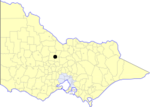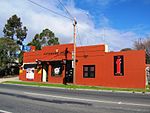Electoral district of Bendigo
1927 establishments in Australia1985 disestablishments in AustraliaFormer electoral districts of Victoria (state)Victoria (state) government stubs
The electoral district of Bendigo was an electorate of the Victorian Legislative Assembly in the Australian state of Victoria. Centred on the city of Bendigo, the district was formed when the electorates of Bendigo East and Bendigo West were merged into a single district in 1927. Bendigo was abolished in 1985 when it was once again split into separate East and West districts.
Excerpt from the Wikipedia article Electoral district of Bendigo (License: CC BY-SA 3.0, Authors).Electoral district of Bendigo
Bannerman Street, Bendigo
Geographical coordinates (GPS) Address Nearby Places Show on map
Geographical coordinates (GPS)
| Latitude | Longitude |
|---|---|
| N -36.75 ° | E 144.26666666667 ° |
Address
Bannerman Street
Bannerman Street
3550 Bendigo (Bendigo)
Victoria, Australia
Open on Google Maps






